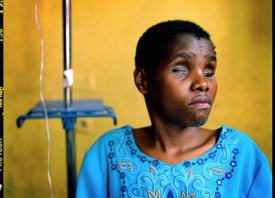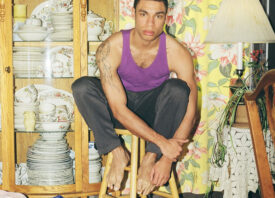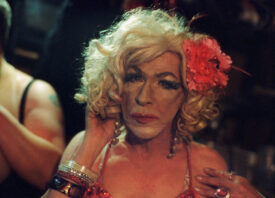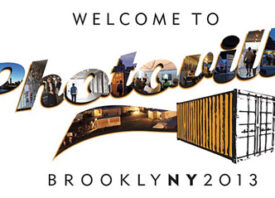Search this site
Donna Ferrato Presents a Lifetime of Work Honoring the Stories of Women


American photographer Donna Ferrato is possessed with a candor you rarely find, a willingness to traverse the most delicate, vulnerable parts of life and do so with extraordinary courage and sensitivity. Long before the mainstream media was paying attention to the issues facing women’s lives, Ferrato was fully attuned to the extraordinary importance of bearing witness.
In her new book Holy (powerHouse Books), Ferrato traverses a lifetime behind the lens documenting the lives of women from all walks of life. Fearlessly confronting once taboo issues like sexual assault, domestic violence, and sex work, Ferrato recognizes photography as a tool to speak truth to power and testify to not only the tragedies and traumas befalling women but the victories that achieve against the odds.
Holy began in 2017 after the U.S. Presidential election left Ferrato feeling enraged. “I was a bear whose paw was caught in a steel trap. I was howling, I was angry, I was furious that that man had been voted in. I knew what was going to happen because we all knew [what he would do]: shutting down Planned Parenthood, women’s health clinics, telling trans people they could not serve in the military and get the health care they needed, taking children away from families at the border — just taking away all of our rights,” she says.
“I couldn’t tolerate it anymore. I was responding like a desperate animal when I first started this book. If you could see he first iteration where I was in a white-hot rage you would understand that I didn’t know where I was going. I’m so flawed. I make so many mistakes. I am driven by my emotions and my impulses, and I’m changing my mind all the time. I’d look at the book and it wasn’t good enough.”
When COVID hit, Ferrato found herself alone. Without distraction, she delved into her past, asking herself, “Where were the cracks in your upbringing that lead you to be such a firebrand?” Here, Ferrato shares a few stories from her extraordinary path.

Can you speak about the idea of documentation as a sacred act, and when you began to realize the camera held spiritual powers?
“It started very early on, when I first photographed the man attacking his wife. I realized that it was such a shocking thing to see. There are so many people afraid of that image that that was when I began to realize it was something sacred — because it was not known, it was not see, and it had the power to move people. They weren’t proud to articulate why they were scared. It cut came so close to their own sense of being — especially for men. Those pictures disturbed a lot of men.
“I was living with a man, Philip Jones Griffith, one of the true documentary apostles, he was right up there with Cartier-Bresson. That was the point of pride, what they were doing was preserving the world around them by simply being there, showing it, and trying not to have footprints. Just be there, don’t change anybody, don’t do anything for them, just be there and capture it.
“I was watching in those early days, in the early 80s. I wasn’t schooled and I didn’t hang out with photographers. I wasn’t an agency photographer. But I had PJG at my side, sleeping next to me. When I would wake up in the night, unable to sleep because of the things that I was seeing that didn’t make sense, feeling so frustrated when I would take my stories around and show them to these magazine editors who would tell me, ‘It’s too complicated Donna, we can’t publish these, we can’t do anything with it, because they need too many captions.’
“They had so many excuses and I would get really discouraged. Philip would always say to me, ‘Don’t worry Donna. If they don’t want to show your pictures, if they’re turning you away and rejecting you, I want you to feel good because you are doing something that’s valuable and that’s why society will reject you and turn away.’
“It wasn’t just looking at the negative side, I wanted to see the beauty as well. I was lucky that I had someone who was my guru. He wasn’t solely mine. He tried to impart that wisdom in Magnum too, although Magnum didn’t want to listen to him. They wanted more fashionable photographers, the art photographers, the photographers who could make big money for the agency. The ‘80s, going into the ‘90s, were some really sad times in the history of photography because that’s when documentary photography was starting to take a hit because people were getting bored with looking at real life.”

What do you think of the idea of the female gaze?
“Running the risk of sounding sexist, I have to say that the female gaze is something of an anomaly because for so long women weren’t really looking at themselves and they weren’t really showing what they see when they look at themselves or their girlfriends. We were so dominated by the male gaze, by what the males want to see, and how they were setting things up for us to be able to see ourselves.
“We were all looking at ourselves through the prism of the male gaze. Not just a prism, a prison. It was really hard for women to see themselves, to understand who they were. For me, the female gaze is also quite sacred because no man can ever understand what is inside a woman, what her body responds to, what makes a woman shut down and then how she rebirths herself.
“Unfortunately, it seems like not a lot of men have even tried to understand it through the year because they didn’t think that the female voice mattered that much. Right now, the female gaze is rising because women are rising. We are seeing so many powerful women coming forward to work, to fight, to speak out, to show how they are, to show their bodies, to talk about everything that was taboo before from menstruation to birth. There’s been a lot of backlash against the idea of motherhood, of single motherhood. Women have been plunging forward doing the things they have to do without getting any recognition.
“For me the female gaze is something crucial right now because it’s about giving recognition, really seeing who women are, not the stereotypes and fallacies. The female gaze is the new frontier. The power of woman is so monumental, we are going to make a really radical change in society and the way we work, we are heard, the way our countries speak to each other. Things are going to change. Violence is going to be taken seriously. That’s because women have the courage to make these changes. They are saying enough is enough. Women looking at other women as they are going forward into this brave new world is going to be the most powerful documentation that we’ve ever had, ever.”

Can you speak about your idea of the holy trinity?
“I am angry a lot. I have been angry about women and the lack of respect for women’s rights, and I haven’t understood it but I kept trying to understand where it came from. All of a sudden, I remembered in those early years when I went to Catholic school, had catechism classes, and how weird it was. That was my big question as a young girl. I was always asking the nuns and the priests, and my mother, ‘Why? Why can’t there be the mother of God? Why do people accept it?’
“Suddenly it hit me, this is where it started. This is where the hatred and fear of women started. They couldn’t give women respect for having given birth with their own bodies to Jesus. They had to make it into some fantasy story about an angel coming through a window. It’s so much like what we’re living with today. The human need. You would think it would be to be curious and to understand the origins of life, and to praise that. I realized I had to attack the Trinity — because to me it was complete fallacy — and then go for it. Who are the really supreme powers on earth? It’s the Mother, because without the Mother the human race will die.
“Of course we need the Father, I am not discounting the Father, but I also felt like the Daughter was important because I want women to understand they are passing their power onto their daughters and not all women understand that became so many women are protecting the patriarchy, their husbands, and the men as head of everything. If the women weren’t protecting the men, then the men would have failed a long time ago. They would have rendered themselves extinct because they are always killing each other.
“Jesus trusted women. He didn’t trust the apostles. They betrayed him. Men aren’t just betraying women, they are betraying each other. I know women betray each other too and I want some recognition of that. I want some recalibration of that. I don’t women to keep standing up for the predators. I am really concerned about that in our society, how we keep protecting the predators. We can change that predator behavior if we show the men they won’t have any way with us. We can ostracize them and they will lose all their privileges. It’s simple how we can attack all of that.

“I needed to say something about that holy alliance between the Mother and the Daughter. I was guilt of it too, as a young girl. I admired my father so much and I saw my mother as having ideals that were impossible for me to live up to and I criticized her all the time for caring about things I thought we inconsequential. I saw my father as being the brave adventurous one who saved lives, was out there in the world, was making money.
“I didn’t understand how my mom was propping him up. She was an enabler. She had always been an enabler of the weak side of men. She took care of them and made it easier for them, but at the same time she was very tough, demanding, and critical with me. As I grew older, I really value her for that because I didn’t want to be spoiled. People who are spoiled can’t survive in the world without their enablers.
“The Others are very important too, but I didn’t know how to express the beauty of the others until I was reading about the octopus. They are brilliant the way they mutate and change. I was looking a way to describe the LGBTQ world, the good sons, the good men and good people who understand the power of women and how that must be protected, so that’s how I formed the Trinity. That came during COVID. That was my epiphany born from being alone and realizing we were on the brink of extinction and somehow I had to make sense of all of this going on inside of me.”


All images: © Donna Ferrato



